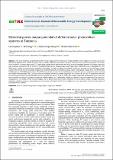| dc.description.abstract | This study examines the photovoltaic (PV) energy output and levelized cost of energy (LCOE) in seven regions of Tanzania across five
different tilt adjustments of 1 MW PV systems. The one-diode model equations and the PVsyst 7.2 software were used in the simulation. The results
reveal variations in energy output and LCOE among the regions and tilt adjustments indicating a strong correlation between PV energy output and
solar irradiance incident on the PV panel. For horizontal mounting, the annual energy output ranges from 1229 MWh/year in Kilimanjaro to 1977
MWh/year in Iringa. Among the three optimal tilt adjustments, annually, monthly and seasonal, the last two are predicted to yield larger energy
outputs, whereas the two axis tracking configuration consistently provides the maximal energy output in all regions, ranging from 1533 MWh/year
in Kilimanjaro to 2762 MWh/year in Iringa. The LCOE analysis demonstrates the cost-effectiveness of solar PV systems compared to grid-connected
and isolated mini-grid tariffs. The LCOE values across the regions and tilt adjustments range from $0.07/kWh to $0.16/kWh. In comparison, the tariff
for grid-connected solar PV is $0.165/kWh, while for isolated mini-grids; it is $0.181/kWh. The monthly optimal tilt configuration proves to be the
most cost-effective option for energy generation in multiple regions, as it consistently exhibits the lowest energy cost compared to the other four
configurations. The results provide valuable insights into the performance and economic feasibility of various system setups. Through meticulous
simulation and data analysis, we have gained a comprehensive understanding of the factors influencing energy generation and costs in the context of
solar photovoltaic systems | en_US |

